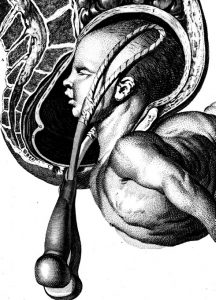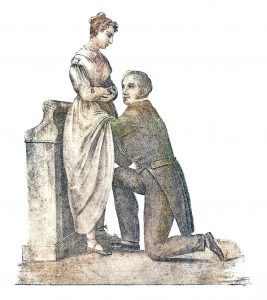Before the 20th century childbirth was a risky business. Many women died from either blood loss during labour or shortly after from puerperal fever. Stillbirth was a common occurrence and there was no safe way to relieve an obstructed labour until a family of Huguenot refugees by the name of Chamberlen, invented the first obstetric forceps. The Chamberlen’s kept their invention secret for over 100 years but their instrument enabled them to deliver children safely in difficult labours.
Peter Chamberlen the elder was born in Paris in 1560. His family was forced to flee to England because of religious persecution. Rather confusingly, Peter the elder had a brother also named Peter. Both brothers were medical practitioners and specialised in midwifery. The elder Peter attended Queen Anne, wife of James I, during her pregnancies and was officially appointed her “accoucheur”, the old term for an obstetrician and derived from the French for lying down. The first maternity hospitals were called “lying in hospitals”.
In 1616 the Chamberlen brothers supported London midwives’ efforts to form a professional society. The proposal was opposed by the Royal College of Physicians who castigated the Chamberlens for having “impudently advocated the cause of these women” and for implying that obstetric surgeons could know more about midwifery than physicians.

It is not certain which of the brothers invented the obstetric forceps but they went to great lengths to keep their secret. The forceps were carried in a box and women giving birth were blindfolded to prevent them seeing the instrument. Nobody else, not even the husband, was allowed in the room.
In 1630, another Peter who was the son of Peter the Younger, was appointed physician accoucheur to Queen Henrietta Maria. He was also keen to promote the midwives cause to form a professional society but he too was opposed by the College of Physicians and curiously by the midwives themselves who disliked his use of forceps and other instruments. The next generation of Chamberlens also included several obstetricians. The eldest, Hugh, hoped to sell the secret of the forceps to the French government but when asked to deliver a woman with a deformed pelvis, he failed to relieve her obstructed labour and had to return to London without a deal. In 1694 he moved to Scotland and proposed the introduction of health insurance for everyone, both rich or poor. It took another 254 years for his vision to be realised with the foundation of the NHS. He also published a scheme showing the advantages of Scotland uniting with England which probably influenced the decision to form the Union in 1707.

Hugh’s son, another Hugh, was a member of the last of the generation to be entrusted with the family secret. Having no male heir, he may have told a number of people about the forceps. By the 1730’s others began to use them and modify their design. The Chamberlen forceps had a curve in one direction to encase the baby’s head but their design was improved by incorporating a second curve to follow the female pelvic anatomy. In the latter decades of the 18th century, they were being widely used around the country. The curved design was attributed to William Smellie, a Scottish obstetrician. Others claim to have had the idea including Benjamin Pugh who lived at Midford Castle and is buried in Freshford parish church; there is a memorial to him above the entrance door. Pugh is also considered a pioneer of infant resuscitation and invented an endotracheal tube enabling air to be blown directly into a baby’s lungs.
In the 18th and early 19th centuries, accoucheurs offering maternity services were sometimes known as men-midwives. These men were surgeon-apothecaries or physicians who specialised in difficult labours which were considered beyond the competence of midwives. Although we have no record of local practitioners’ work, evidence from diaries and case books kept by some practitioners in other parts of the country show that their hours were long with little or no opportunity for sleep.


A midwife’s hours could be equally long although normal births tended to progress more quickly than those requiring the services of a man-midwife. Until the later 18th century few midwives were able to cope with difficult labours. One exception was Mrs Sarah Stone who worked in Bristol, Taunton and Bridgewater between 1700 and 1738 and kept case records which have been recently published by Liverpool University Press in a book called Mrs Stone and Dr Smellie, written by Robert Woods and Chris Galley.
Article by Dr Roger Rolls